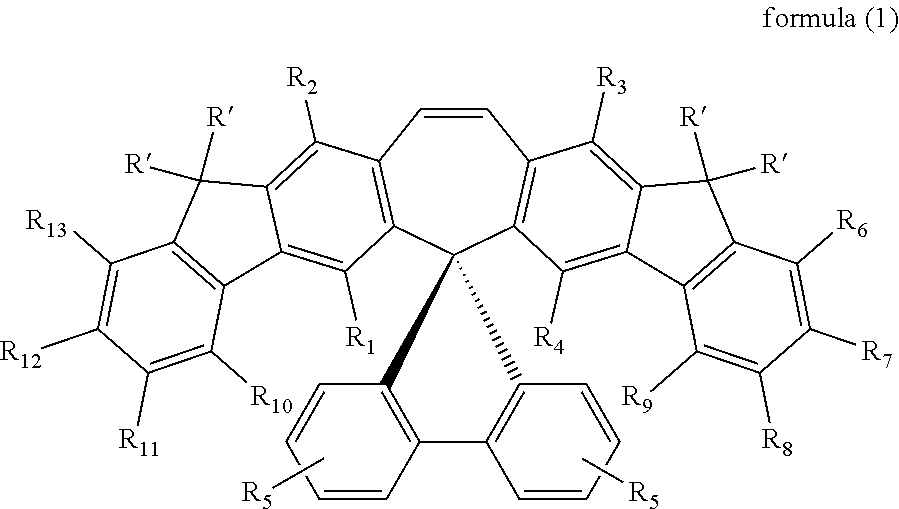Spirally configured cis-stilbene/fluorene hybrid material and organic electroluminescent device using the same
- Summary
- Abstract
- Description
- Claims
- Application Information
AI Technical Summary
Benefits of technology
Problems solved by technology
Method used
Image
Examples
example 1
of Compound 7 (3,7-dibromo-5,5-spirofluorenyl-5H-dibenzo[a,d]cycloheptene)
[0067]A stir bar was placed in a 250 ml two-necked, round-bottomed flask, followed by being dried by vacuum and introduced with nitrogen. An organolithium reagent is then prepared by dropwisely adding 2.5 M n-butyllithium hexane solution (12 ml, 30 mmol) into a solution of 2-bromobiphenyl (6.996 g, 30 mmol) dissolved in anhydryous tetrahydrofuran (100 ml) and placed in the 250 ml flask at −78° C., followed by reaction for 30 minutes. 3,7-dibromo-dibenzo[a,d]cyclo-hepten-5-one (7.28 g, 20 mmol) was dissolved in anhydrous tetrahydrofuran (60 ml) and placed into a 500 ml two-necked flask after the 500 ml flask was dried by vacuum and introduced with nitrogen. The prepared organolilthium reagent was then drop-wisely added into the 500 ml flask containing the dissolved 3,7-dibromo-dibenzo[a,d]cyclo-hepten-5-one through a double-tipped needle. After the temperature of the reaction mixture was returned to the room te...
example 2
of Compound 8 (diethyl 2,2′-(spiro[dibenzo[a,d][7]annulene-5,9′-fluorene]-3,7-diyl)di-benzoate)
[0070]A stir bar was placed in a 50 ml two-necked round-bottomed flask, followed by being dried by vacuum and introduced with nitrogen. The compound 7 (501 mg, 1 mmol), potassium carbonate (690 mg, 5 mmol), Pd(PPh3)4 as catalyst, 8 ml of toluene and 2 ml of ethanol were added into the 50 ml flask, followed by stirring for 10 minutes. After stirring, 2-(ethoxycarbonyl) phenylboronic acid (580 mg, 2.1 mmol) was added. The resulting mixture was then heated to 80° C. After reacting for 24 hours, the reaction mixture was then cooled down to the room temperature, followed by quenching with 20 ml water and then being extracted with dichloromethane (3×20 ml). The combined organic extractant was added with magnesium sulfate (about 500 mg) to dry, followed by filtration and condensation with a rotary evaporator to remove the solvent, so as to obtain a crude product. The crude product was then purifi...
example 3
of Compound 1 (12,12,17,17-tetraphenyl-12,17-dihydrospiro[cyclohepta[1,2-b:5,4-b′]-difluorene-6,9′-fluorene])
[0072]A stir bar was placed in a 50 ml two-necked round-bottomed flask, followed by being dried by vacuum and introduced with nitrogen. A reaction mixture was prepared by dropwisely adding 2.0 M phenyllithium di-n-butyl ether solution (2.75 ml, 5.5 mmol) into a solution of the compound 8 (639 mg, 1 mmol) dissolved in anhydryous tetrahydrofuran (100 ml) and placed in the 50 ml flask at −78° C., followed by reaction for 3 hours. After the temperature of the reaction mixture was returned to the room temperature, 3 ml of saturated aqueous sodium bicarbonate solution was introduced to quench the reaction. The resulting mixture was then extracted with dichloromethane (3×20 ml). The obtained organic extractant was added with magnesium sulfate (about 500 mg) to dry, followed by filtration and condensation with a rotary evaporator to remove the solvent, so as to obtain an intermediate...
PUM
| Property | Measurement | Unit |
|---|---|---|
| Temperature | aaaaa | aaaaa |
| Temperature | aaaaa | aaaaa |
| Glass transition temperature | aaaaa | aaaaa |
Abstract
Description
Claims
Application Information
 Login to View More
Login to View More - R&D
- Intellectual Property
- Life Sciences
- Materials
- Tech Scout
- Unparalleled Data Quality
- Higher Quality Content
- 60% Fewer Hallucinations
Browse by: Latest US Patents, China's latest patents, Technical Efficacy Thesaurus, Application Domain, Technology Topic, Popular Technical Reports.
© 2025 PatSnap. All rights reserved.Legal|Privacy policy|Modern Slavery Act Transparency Statement|Sitemap|About US| Contact US: help@patsnap.com



